

Timo Moilanen
-
Posts
97 -
Joined
-
Last visited
Content Type
Profiles
Forums
Events
Posts posted by Timo Moilanen
-
-
Yes and at short distances these sideways "vector * sin(a)"cancel each other out , but they not disappear and on long distances they "work" in same radial direction (sin(a) =>0 ; cos(a)=>1)and make a sphere seem like a point mass.
And then there are the Sigma dM/r2 that is =3/2*M/r2 at r=R(surface) that I cal Ftot when multiplied by Ti
0 -
6 hours ago, Klaynos said:
That must mean that Ti is body dependent
G is body dependent , Ti is not . As I write in my paper 2:nd page F = Ti *M1*M2 /r2 but Ti = F * k1 * k2 * r2 /(M1 *M2 ) ,
And that is because a sphere is not acting like a mass point when calculating Ti , but when measuring F and calculating Fm it is absolutely like a mass point. The slightly sideways dF vectors and all different distances r + - R and cos(a) mean for example that Fm on surface on a even density sphere is M*Ti but Ftot =3/2*M*Ti , k=1.5
G is calculated directly from Fm and measures is done when r is about 1.2 to1.3 R and k values k1 *k2 = some 1.12
that should have been multiplied to G , but there wee no k values thought of . It is an oddity that F=M*Ti on a sphere , all other shapes and density divergence need much more calc. The "easy" calculus do'nt go for Ftot .
And for the easy calculation , I have not heard anyone integrate V/r2 before or after I did it last December
0 -
On 10/10/2017 at 0:59 PM, swansont said:
What are the units here? m2/(s2-mol)? How do you get Nm2/kg2 from that?
The units must stay as earlier to complete the formula , The mol-1 is not there Ti=c^2*M'/2000NA ,M' = molar mass for protons and neutrons . => (m/s)2*kg/mol/[(g/kg)*mol-1] . The kg to M' is" borrowed" ,units for Ti so far (m2/s2 )/kg .1/2 Mc2 => in ( kg m2/s2) gives [E] =J=Nm and this by a "borrowed "kg gives Nm/kg2 . This is the potential energy between two masses(yet to come) at distance 1m . but as we know this "spring" is not k*x=F (Hooke) but k/x^2=F Since Fgrav=- k/x2 and UorE=k/x => [Ti]=Nm2/kg2.
here (the integral) require either to be negative , and i would prefer negative Ti to negative Energy
On 10/10/2017 at 1:48 PM, Klaynos said:Would I be correct in saying that in all cases you think that
GM = TiM'
Where G is the gravitational constant, M is mass, Ti is your constant and M' is your modified mass?
No M' is the molar mass and M is used for it ,This [M]=g/mol =kg/kmol , right from chemistry and GM=TiM ,because M' is part of Ti
18 minutes ago, Timo Moilanen said:The units must stay as earlier to complete the formula , The mol-1 is not there Ti=c^2*M'/2000NA ,M' = molar mass for protons and neutrons . => (m/s)2*kg/mol/[(g/kg)*mol-1] . The kg to M' is" borrowed" ,units for Ti so far (m2/s2 )/kg .1/2 Mc2 => in ( kg m2/s2) gives [E] =J=Nm and this by a "borrowed "kg gives Nm/kg2 . This is the potential energy between two masses(yet to come) at distance 1m . but as we know this "spring" is not k*x=F (Hooke) but k/x^2=F Since Fgrav=- k/x2 and UorE=k/x => [Ti]=Nm2/kg2.
here (the integral) require either to be negative , and i would prefer negative Ti to negative Energy
No M' is the molar mass and M is used for it ,This [M]=g/mol =kg/kmol , right from chemistry and GM=TiM ,because M' is part of Ti
M' in this case = molar mass of (neutrons and protons )= 1g/mol = 1kg/1000mol=1kg/kmol
0 -
All involved have agreed on a common (average ) value of G , and that is necessary to make "things work".
So far there have been no alternative at all . Now I introduce a coefficient that is unambiguous Ti= 1/2*c2 /NA /1000g/kg , all constants well known, and by my calculation also in signification exactly what G is supposed to stand for.
Here some more math to calculate Gravitation force and when needed Ti . I'm ready to prove my point expeimentally
0 -
In measuring the value of Ti it differs from G because I take into account the sideways parts of the dF " vectors " that cancel out each other at close distances . At longer distance all vectors come from same direction and the gravitation "work" at full efficiency =Ti calculated from Ftot .
All applications using gravity as a parameter are adjusted to G as " standardized value , and so are the " authoritative " science too . It's evident there must be consensus about this ( thats why I renamed Ti) , but at some point I hope at least science stop multiplicating "the cosmos " with 0.89 , or dividing . I think it often is equalised ,that's no good excuse in the future .
The logic of measurement calculus G vs. Ti is the point , and only difference .
What comes to explaining , I'm a "foreigner ".
0 -
Earth angular rotation speed w =2 pi rad /86164s =7,2921*10-5/s and the height over earth midpoint is r
We have formula r=(GM/w^2)^(1/3) for G I put in Ti 7.46 *10-11 Nm2/kg2but for earth mass I insist 5,344 *1024 kg
r= (7.4972*1022 m3 )^(1/3) =42166415m => 42166km- 6378km =35788 km over sealevel
My point is still that gravitation constant and earth mass is different from "customary belief" , so both must shange for satellite to stay in sky
0 -
It should be different , it's calculated on the principle that all dM parts have the same constant all time and Ti is calculated from that Ftot . Traditionally the constant G is calculated from F where the from sides coming force component is left uncounted for ( it is not measurable ) , but by my meaning it must count at all distances same way as far away => cos (a)=1 The falsified suggestion is really offending
0 -
In my very thorough research on the gravity constant I made a connection between known constants ( G , c ; NA ) After a solid year of research on the gravitation constant , that I now say is 7.46209031*10-11 Nm2/kg2 , I have to question its real nature . It seem to be a mere modulus (multiplier) when modifying the qualities of kg*kg and mass .Here some short notes picked from my work to this topic.
I'm very sorry for my still poor writing , and the shortness almost looses the ideas . On FB< Essence of gravitation > , hear from you.
0 -
I have via research on the gravitation constant managed to couple Avogadros number ( as amount of neutons +protons ) to Newtons F=MG/r2 . It looks mush like gravitation would be in elementary particles and their features "before reaching relativistic circumstances " , But where did they" come from" url deleted
0 -
s



Sorry again . I'm too upset coz I published new formula and got banned from that site (Ursa). I wrote wrong and correct now g =Ti*M*(1/r^2 -3R^2/(14r^4)) and Ti =7,42*10^-11 Nm2/kg2 . I know my writing is bad but hardly a reason for banning me from a cite , so I suppose my work is stolen now . yours Timo Moilanen
0 -
You know there is a very easy way to show this theory as completely wrong. Start with any scalar field of uniform mass distribution.
the use the formula [latex]F=\nabla\theta[/latex]
where [latex]\nabla[/latex]is the gradient
[latex]\theta[/latex] some scalar potential doesn't matter what.
the reason for the minus sign is to denote a conservative force
then from Stokes theorem we have for gravitational and electrostatic forces
[latex]V=C\frac{\hat{r}}{r^2}=C\frac{\hat{r}}{r^3}[/latex] to the immediate right of the first equal sign is gravitational the immediate right of the second equal sign is electrostatic.
C is a constant for gravity [latex]C=-Gm_1M_2[/latex] for electrostatic we use the coulombs law of electrostatics. [latex]C=q_1q_2 4\pi\epsilon_o[/latex]
V=force
taking [latex]F_g=-\frac{Gm_1m_2\hat{r}}{r^2}=\frac{k\hat{r^2}}{r^2}[/latex]
starting from infinity [latex]\theta_g r-\theta_G\infty=-\int^\infty_r F_g*dr[/latex]
The above requires applications of Stokes theorem I am skipping over the cartesian coordinate expansions. However the simple consequence of these formulas is that the force is radial from a Centre of effective mass. <<<THIS IS OBVIOUS AS PLANETS ARE ROUND>>> due to conservation of energy.
Just as water droplets form round shapes. the work done by the coulombs force and conservation of energy itself shows that the force is radially inward.
if gravity was not radially outward from a center of mass then stars and planets would not be in the conserved shape they are in.
Neither would water droplets which the same fomulas above can be used for.
Key wording Orbit, if the force was not radial outward from a Center of mass objects would have a different orbit.
So lets sit down and list OBSERVATION EVIDENCE YOUR THEORY IS WRONG
1) Shape of planets and Stars
2) path of Orbits
3) shape of galaxies
4) shape of water droplets
5) shape of any falling liquid with some cohesive force
6) pendulum tests to show the Earth isn't Flat
That isn't enough to convince you then you best step up your math because your formulas thus far are garbage.
However lets show gravity of a Planet and Star under GR shall we...
In the presence of matter or when matter is not too distant physical distances between two points change. For example an approximately static distribution of matter in region D. Can be replaced by tve equivalent mass
[latex]M=\int_Dd^3x\rho(\overrightarrow{x})[/latex] concentrated at a point [latex]\overrightarrow{x}_0=M^{-1}\int_Dd^3x\overrightarrow{x}\rho(\overrightarrow{x})[/latex]
Which we can choose to be at the origin
[latex]\overrightarrow{x}=\overrightarrow{0}[/latex]
Sources outside region D the following Newton potential at [latex]\overrightarrow{x}[/latex]
[latex]\phi_N(\overrightarrow{x})=-G_N\frac{M}{r}[/latex]
Where [latex] G_n=6.673*10^{-11}m^3/KG s^2[/latex] and [latex]r\equiv||\overrightarrow{x}||[/latex]
According to Einsteins theory the physical distance of objects in the gravitational field of this mass distribution is described by the line element.
[latex]ds^2=c^2(1+\frac{2\phi_N}{c^2})-\frac{dr^2}{1+2\phi_N/c^2}-r^2d\Omega^2[/latex]
Where [latex]d\Omega^2=d\theta^2+sin^2(\theta)d\varphi^2[/latex] denotes the volume element of a 2d sphere
[latex]\theta\in(0,\pi)[/latex] and [latex]\varphi\in(0,\pi)[/latex] are the two angles fully covering the sphere.
The general relativistic form is.
[latex]ds^2=g_{\mu\nu}(x)dx^\mu x^\nu[/latex]
By comparing the last two equations we can find the static mass distribution in spherical coordinates.
[latex](r,\theta\varphi)[/latex]
[latex]G_{\mu\nu}=\begin{pmatrix}1+2\phi_N/c^2&0&0&0\\0&-(1+2\phi_N/c^2)^{-1}&0&0\\0&0&-r^2&0\\0&0&0&-r^2sin^2(\theta)\end{pmatrix}[/latex]
Now that we have defined our static multi particle field.
Our next step is to define the geodesic to include the principle of equivalence. Followed by General Covariance.
Ok so now the Principle of Equivalence.
You can google that term for more detail
but in the same format as above
[latex]m_i=m_g...m_i\frac{d^2\overrightarrow{x}}{dt^2}=m_g\overrightarrow{g}[/latex]
[latex]\overrightarrow{g}-\bigtriangledown\phi_N[/latex]
Denotes the gravitational field above.
Now General Covariance. Which use the ds^2 line elements above and the Einstein tensor it follows that the line element above is invariant under general coordinate transformation(diffeomorphism)
[latex]x\mu\rightarrow\tilde{x}^\mu(x)[/latex]
Provided ds^2 is invariant
[latex]ds^2=d\tilde{s}^2[/latex] an infinitesimal coordinate transformation
[latex]d\tilde{x}^\mu=\frac{\partial\tilde{x}^\mu}{\partial x^\alpha}dx^\alpha[/latex]
With the line element invariance
[latex]\tilde{g}_{\mu\nu}(\tilde{x})=\frac{\partial\tilde{x}^\mu \partial\tilde{x}^\nu}{\partial x^\alpha\partial x^\beta} g_{\alpha\beta}x[/latex]
The inverse of the metric tensor transforms as
[latex]\tilde{g}^{\mu\nu}(\tilde{x})=\frac{\partial\tilde{x}^\mu \partial\tilde{x}^\nu}{\partial x^\alpha\partial x^\beta} g^{\alpha\beta}x[/latex]
In GR one introduces the notion of covariant vectors [latex]A_\mu[/latex] and contravariant [latex]A^\mu[/latex] which is related as [latex]A_\mu=G_{\mu\nu} A^\nu[/latex] conversely the inverse is [latex]A^\mu=G^{\mu\nu} A_\nu[/latex] the metric tensor can be defined as
[latex]g^{\mu\rho}g_{\rho\nu}=\delta^\mu_\mu[/latex] where [latex]\delta^\mu_nu[/latex]=diag(1,1,1,1) which denotes the Kronecker delta.
Finally we can start to look at geodesics.
Let us consider a free falling observer. O who erects a special coordinate system such that particles move along trajectories [latex]\xi^\mu=\xi^\mu (t)=(\xi^0,x^i)[/latex]
Specified by a non accelerated motion. Described as
[latex]\frac{d^2\xi^\mu}{ds^2}[/latex]
Where the line element ds=cdt such that
[latex]ds^2=c^2dt^2=\eta_{\mu\nu}d\xi^\mu d\xi^\nu[/latex]
Now assunme that the motion of O changes in such a way that it can be described by a coordinate transformation.
[latex]d\xi^\mu=\frac{\partial\xi^\mu}{\partial x^\alpha}dx^\alpha, x^\mu=(ct,x^0)[/latex]
This and the previous non accelerated equation imply that the observer O, will percieve an accelerated motion of particles governed by the Geodesic equation.
[latex]\frac{d^2x^\mu}{ds^2}+\Gamma^\mu_{\alpha\beta}(x)\frac{dx^\alpha}{ds}\frac{dx^\beta}{ds}=0[/latex]
Where the new line element is given by
[latex]ds^2=g_{\mu\nu}(x)dx^\mu dx^\nu[/latex] and [latex] g_{\mu\nu}=\frac{\partial\xi^\alpha}{\partial\xi x^\mu}\frac{\partial\xi^\beta}{\partial x^\nu}\eta_{\alpha\beta}[/latex]
and [latex]\Gamma^\mu_{\alpha\beta}=\frac{\partial x^\mu}{\partial\eta^\nu}\frac{\partial^2\xi^\nu}{\partial x^\alpha\partial x^\beta}[/latex]
Denote the metric tensor and the affine Levi-Civita connection respectively
As you begin (physics course) " for any uniform massdistribution " and this is very true for any "force" that is exactly proportional to d M/r^2 , and we probably can assume I do not think gravity is one of them , but should be calculated from cg or whatever midpoint gravity can be called and is situated dr= 2R^2/5r closer to observation height than sph. midpoint so dM/(r-2R^2/5r)^2
and that I'm going to explore further and it give almost impossible to " swallow " different perspective and after all maybe classic mechanics also is right ( Newton , Euler a.s.o)
As you begin (physics course) " for any uniform massdistribution " and this is very true for any "force" that is exactly proportional to d M/r^2 , and we probably can assume I do not think gravity is one of them , but should be calculated from cg or whatever midpoint gravity can be called and is situated dr= 2R^2/5r closer to observation height than sph. midpoint so dM/(r-2R^2/5r)^2
and that I'm going to explore further and it give almost impossible to " swallow " different perspective and after all maybe classic mechanics also is right ( Newton , Euler a.s.o)
And I would be very interested in opinions of my integrals since they don't contradict any "modern belief " and should there for be harder to "declare" wrong .
As you begin (physics course) " for any uniform massdistribution " and this is very true for any "force" that is exactly proportional to d M/r^2 , and we probably can assume I do not think gravity is one of them , but should be calculated from cg or whatever midpoint gravity can be called and is situated dr= 2R^2/5r closer to observation height than sph. midpoint so dM/(r-2R^2/5r)^2
and that I'm going to explore further and it give almost impossible to " swallow " different perspective and after all maybe classic mechanics also is right ( Newton , Euler a.s.o)
And I would be very interested in opinions of my integrals since they don't contradict any "modern belief " and should there for be harder to "declare" wrong .
Newton would have loved the first (two parted) one
0 -
After sniffing the air here I'm happy to see that my theory holds all arguments so far it's only wrong
Now I have searched ( not very deep ) and did'n find the R1, R2 and r values that are essential for me There's more to dig
To get 0 from (r^2-R^2), when r=1, you need to have R=1 (or -1).
But if you see what you called a.s.o.
there in denominator:
(r+R)(r-R)
If r=1 and R=1, then r=R, and denominator:
(1+1)(1-1)
equals 0.
And you will end up dividing by 0!
Yes and before the parenthesis it's multiplied by 0 to be sure and that part of equation is gone ( =0) With R = 0,9999999 it make F=- GmM/ 2,00000001 but its not my equation so?
You can look up the height of a geostationary orbit (and how it is calculated): https://en.wikipedia.org/wiki/Geostationary_orbit
Note that (1) it is calculated using Newton's law of gravitation and (2) we have launched geostationary satellites and so we know that calculation is correct. we also, therefore, know that your equation is wrong. You can't keep denying this.
Please provide some evidence for this. So far the only evidence you have provided proves you wrong.
The math is straight forward but as I expect you to mean the mass , so that is undone for any theorem
-2 -
That doesn't make much sense. Please show your working in detail.
If you dont understand this short calc. I'm afraid I can't help from here
If your model produces only incorrect results, then the model is wrong.
That is nothing to do with this website or me.
Why would anyone use an equation that gives the wrong results in 100% of cases?
EXACTLY what was the right answers again and how is the right way of finding them
If you dont understand this short calc. I'm afraid I can't help from here
EXACTLY what was the right answers again and how is the right way of finding them
All measurements and most predictions from them will come out similar or very near , except ALL stellar MASSES change RADICALLY . So there really is only one minor adjustment
0 -
You: the only prediction you have made was wrong.
So: 1 wrong prediction; zero correct predictions = no support.
So you mean that this single site is where support /no support and thereby right/wrong is decided (by Strange)
0 -
Of course not. How could they? Why do you think that?
Therefore Ti = G.
You need to insert r=1 before reducing r away obviously F=-GmM/(4Rr^2)*{ 2R-(r^2-R^2)*[a.s.o.]} => F=-GmM/4R*{2R-0*[ ] } => F=-GmM /2
-2 -
Of course not. How could they? Why do you think that?
Therefore Ti = G.
No because on shorter distances g = Ti M/(p-R^2/p)^2 must be right and that do not fit with G . So the only solution is that the "known" mass is much bigger . And G is supposed to be proven by the masses and the masses is calculated from G , how conwinient but in fact the same must also apply to Ti because we still have [kg] . The distance unit thou is[ R ] and distance therefor n*R =p
0 -
After sniffing the air here I'm happy to see that my theory holds all arguments so far it's only wrong
And who says the theory found no support ? It is anyhow without (magic ) and chaos, simply classical mechanics and some vectors and a reasonable simple logic . However the gravity particle look like , their qualities need to be summed up to form a gravity of "macro" physical size
0 -
That does not matter. They are the same equation, just before transformation..
And yet give different answer ?. One mainpoint is that now M*G = Ti *M
-1 -
After sniffing the air here I'm happy to see that my theory holds all arguments so far it's only wrong
G measurements with newer methods and old theory will end up in G being 8,05*10^-11 Nm2/kg2 , when gap between masses goes to near 0 and R2 to small(free atoms ) .Cylinders give smaller ca. (8,05-6,67)/3+ 6,67 = 7,1 *10^-11
-2 -
Have you even looked for this data? Presumably not.
See posts 26 and 31 to get you started.
http://rsta.royalsocietypublishing.org/content/372/2026/20140022
https://scholar.google.co.uk/scholar?q=measuring+the+gravitational+constant
If you are too lazy to find support for your "theory" then no one is going to take you seriously.
After sniffing the air here I'm happy to see that my theory holds all arguments so far it's only wrong
-3 -
There is more astronomical data out there than masses. Do you disagree with orbital periods, too? How about distances?
Just masses and constant G much wrong
???
How?
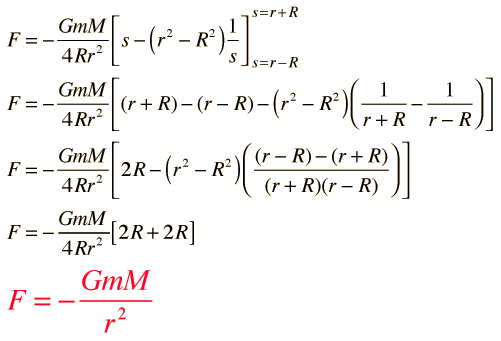
If You have R=1 and r=1 then
[math]F=-\frac{GmM}{4Rr^2}*(2R+2R)[/math]
[math]F=-\frac{GmM}{4*1*1^2}*(4*1)[/math]
4*R cancels with 4*R...
[math]F=-\frac{GmM}{1^2}[/math]
I should have said third and forth formula from end
0 -
Perhaps you need to explain why you think these measurements do not exist. Then we can explain why you are wrong.
There are for me useful "measurements to set const. Ti . Cavendish experiments with spheric masses .but I need details of the masses radiuses and r the distance . That might not seem very important to labs. who do experiments , otherwice than publicing them is like giving away their quite expensive job for free . G = Ti* f(R1,R2, r) as I see it
0 -
Of course he did. Don't be so stupid.
https://en.wikipedia.org/wiki/Shell_theorem
As swansont points out you can test your equation by choosing a pair of spherical masses with any mass, any radius and any separation. Then compare your results with Newton. If your results are different then they are wrong.
The result on small (laboratory) spheres will give same F(force) results as far as accuracy goes today , but " the my theory " will give a more "stable" constant not tending to change with increased mass for example as today. On the right scale (world) they will prove very different and to that I have not enough data or computing capacity and most of all astronomers skills and accumulated experience
The result on small (laboratory) spheres will give same F(force) results as far as accuracy goes today , but " the my theory " will give a more "stable" constant not tending to change with increased mass for example as today. On the right scale (world) they will prove very different and to that I have not enough data or computing capacity and most of all astronomers skills and accumulated experience
http://hyperphysics.phy-astr.gsu.edu/hbase/Mechanics/sphshell.html Here you can insert R=1 and r=1 in the second from bottom and third from bottom formulas and get F= GmM/(2r^2) , That is absolutely my finding for the most outher shells arithmaticly done on computer . I can only say that Gauss had something little wrong or we interprete him too widely
0 -
So you will get the wrong answer. I expect this is the main reason your "theory" is wrong. There may be others. But as you have failed to explain anything, it is not clear.
I doubt it very much.
The "my theory " will survive and prove right because physics do not need human acception . I do not see me allowed to keep this kind of "finding" to myself , but your "funktion" in this is for me more and more unclear
-2

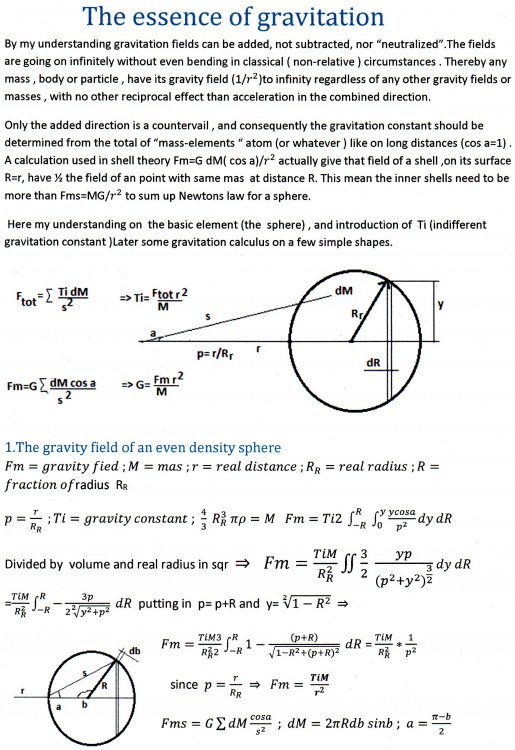
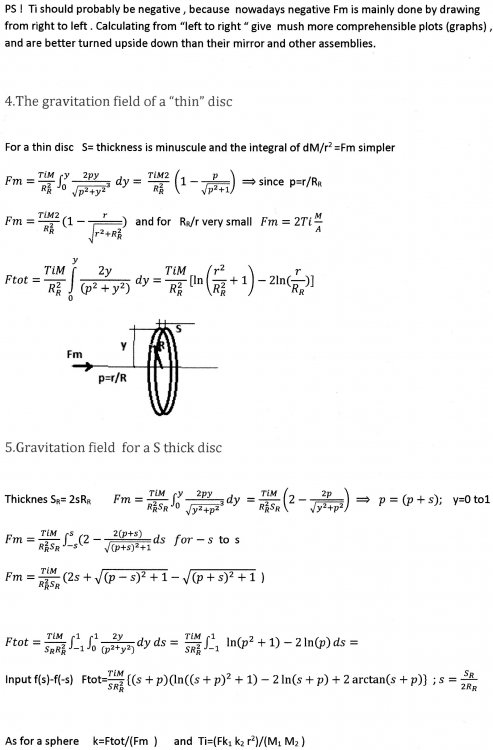
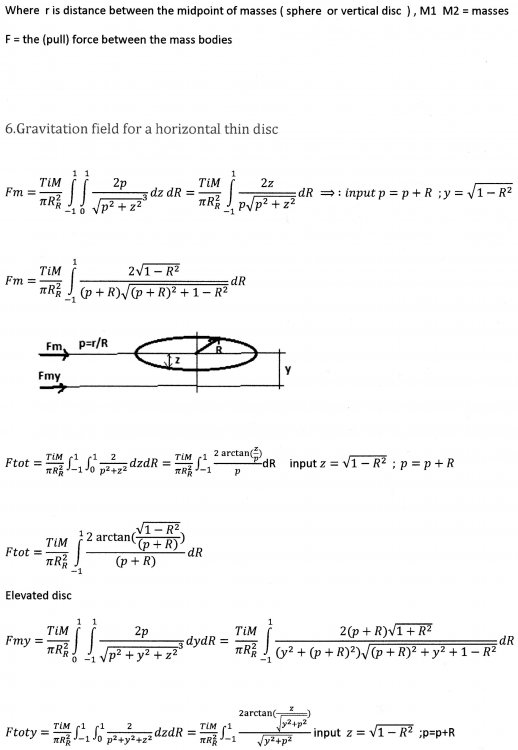
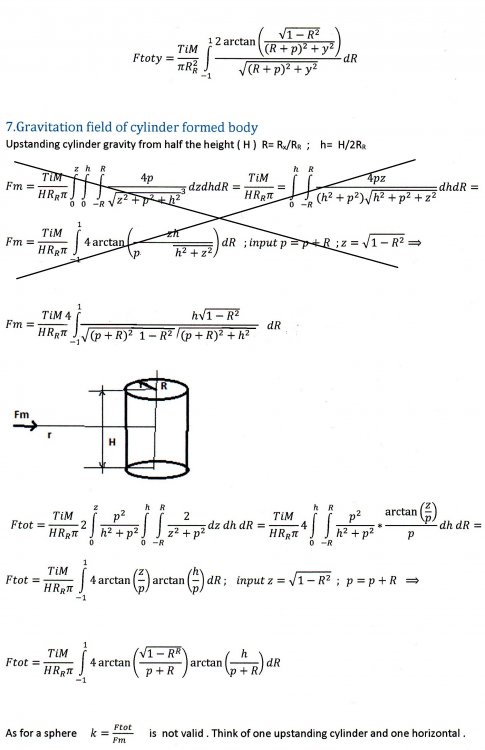
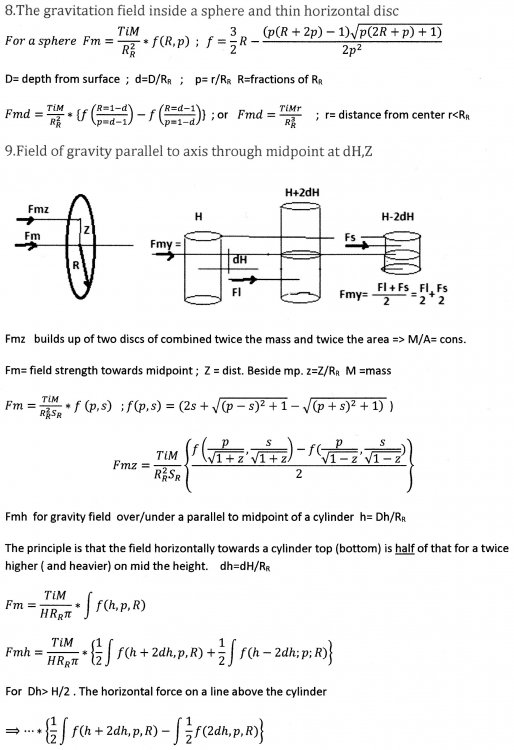
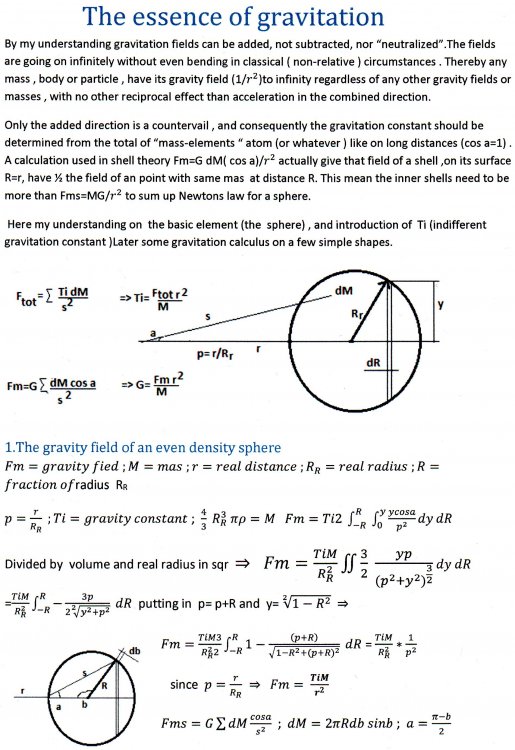
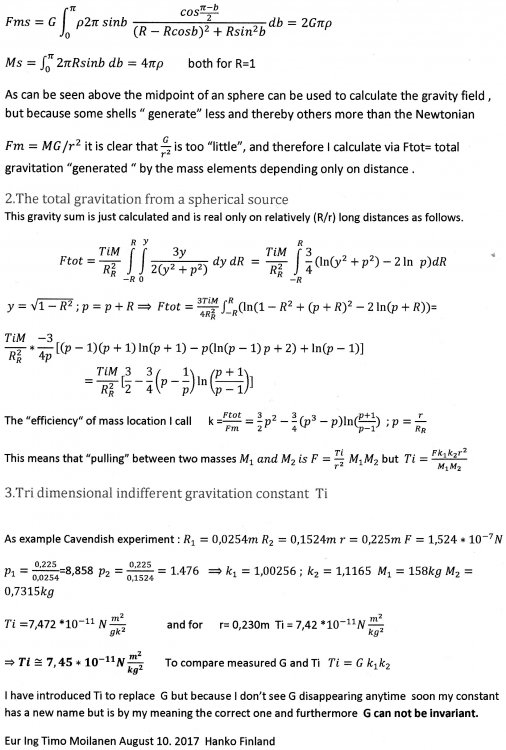
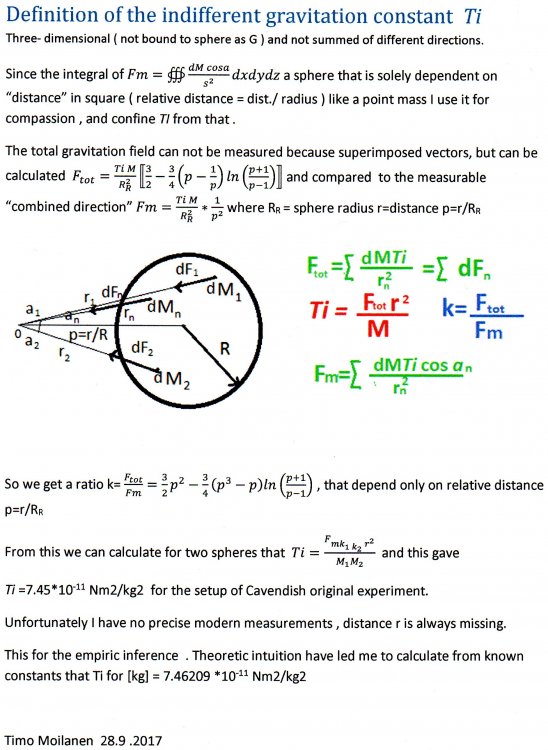
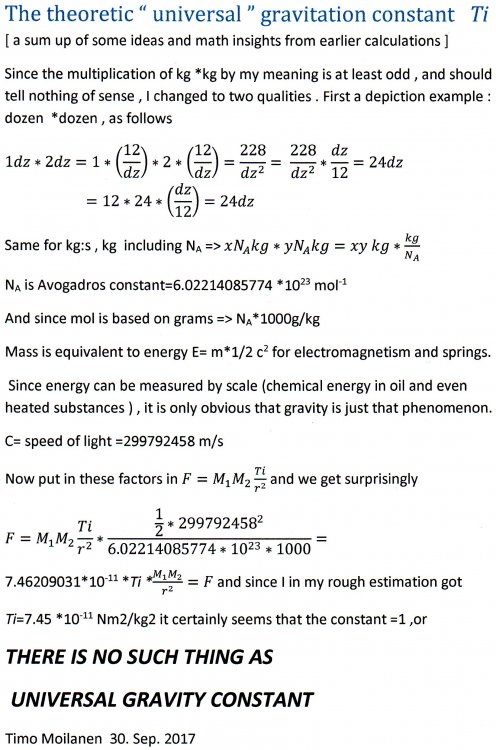
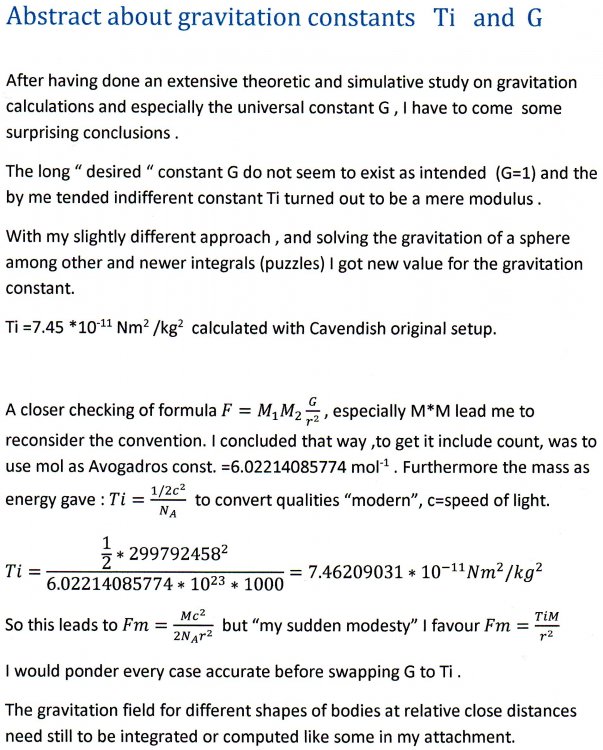
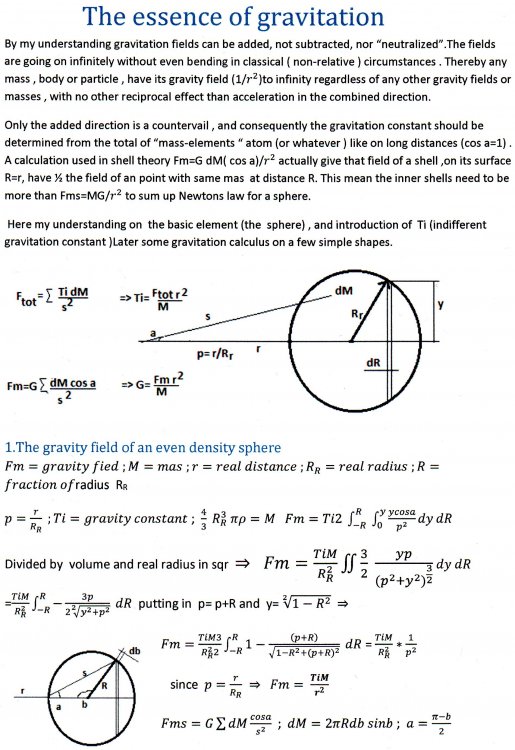
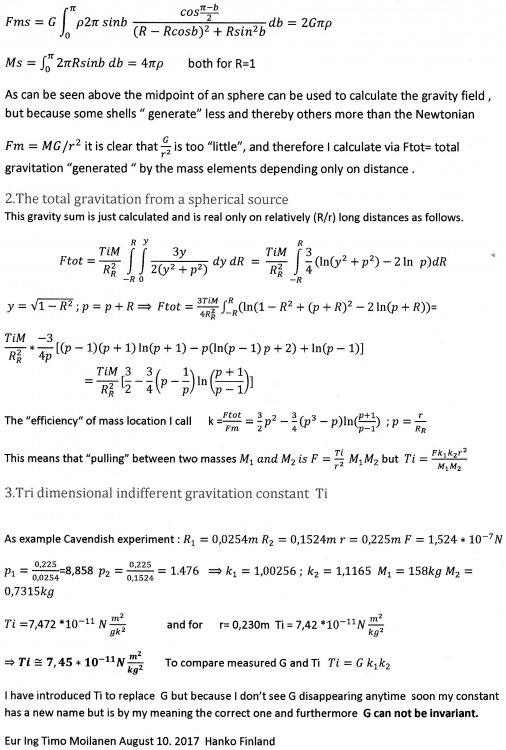
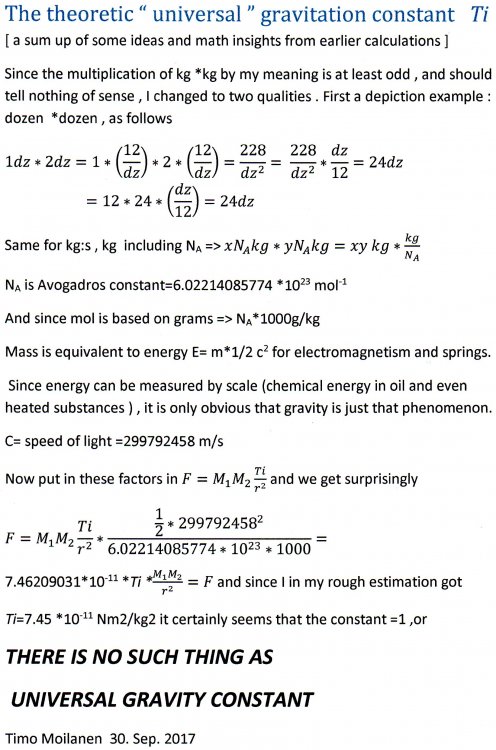
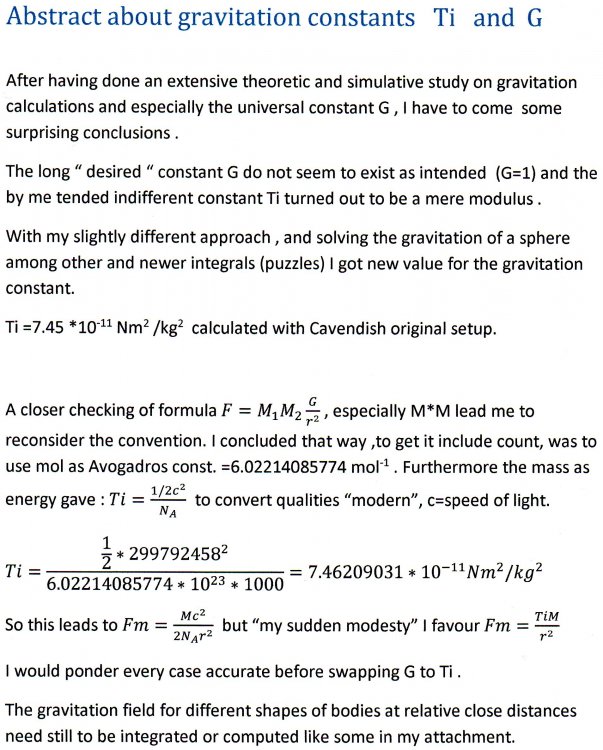
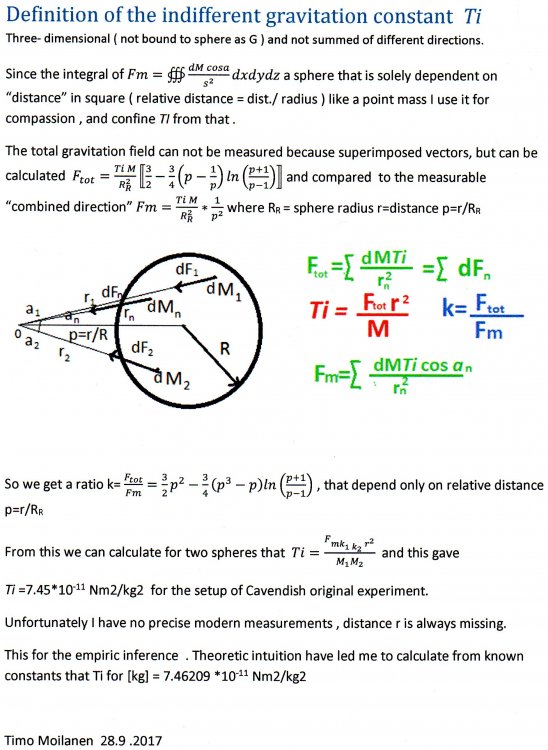
Gravitation constant or not
in Speculations
Posted
I'm sorry I'm messing up . For objects the factor k is also needed when calculating Fm =TiM/(kr2 ) or F= Ti M1 M2 /(k1 k2 r2 )
k for spheres is Ftot / Fm = 3p2 /2 - 3/4(p3 -p)*ln[(p+1)/(p-1)] and this mean that spheres are not like point masses .
This means Earth has an more complex gravitation field than F/r2 and the shell distributed density " actually smoothen it some , but should by my meaning have made satellites on lower orbits dependent on empirical knowledge , the geostationary ones are only 0.03% lower than would be for a point mass.